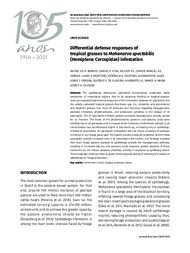Differential defense responses of tropical grasses to Mahanarva spectabilis (Hemiptera: Cercopidae) infestation.
Differential defense responses of tropical grasses to Mahanarva spectabilis (Hemiptera: Cercopidae) infestation.
Autoria: BARROS, R. de A.; VITAL, C. E.; SILVA JÚNIOR, N. R.; VARGAS, M. A. S.; MONTEIRO, L. P.; FAUSTINO, V. A.; AUAD, A. M.; PEREIRA, J. F.; OLIVEIRA, E. E. de; RAMOS, H. J. O.; OLIVEIRA, M. G. de A.
Resumo: The spittlebugs Mahanarva spectabilis economically challenges cattle production of neotropical regions, due to its voracious feeding on tropical grasses. Here, we evaluated biochemical responses of the interaction between M. spectabilis and the widely cultivated tropical grasses Brachiaria spp. (i.e., brizantha and decumbens) and elephant grasses (cvs. Roxo de Botucatu and Pioneiro), regarding lipoxygenases, protease inhibitors, phytohormones, and proteolytic activities in the midgut of M. spectabilis. The M. spectabilis-infested grasses increased lipoxygenases activity, except for cv. Pioneiro. The levels of the phytohormones jasmonic and abscisic acids were similarly low in all genotypes and increased under herbivory. Furthermore, salicylic acid concentration was constitutively higher in Brachiaria sp., increasing only in spittlebug-infested B. decumbens. M. spectabilis infestations did not induce increases of protease inhibitors in any forage grass type. The trypsin activity remained unaltered, and the total proteolytic activity increased only in B decumbens-fed insects. Our findings revealed that most forage grasses exposed to spittlebugs activate the lipoxygenases pathway, resulting in increased abscisic and jasmonic acids. However, greater amounts of these hormones do not induce protease inhibitory activity in response to spittlebug attack. This knowledge certainly helps to guide future projects aiming at reducing the impact of spittlebugs on forage production.
Ano de publicação: 2021
Tipo de publicação: Artigo de periódico
Unidade: Embrapa Gado de Leite
Observações
1 - Por padrão são exibidas publicações dos últimos 20 anos. Para encontrar publicações mais antigas, configure o filtro ano de publicação, colocando o ano a partir do qual você deseja encontrar publicações. O filtro está na coluna da esquerda na busca acima.
2 - Para ler algumas publicações da Embrapa (apenas as que estão em formato ePub), é necessário ter, no celular ou computador, um desses softwares gratuitos. Sistemas Android: Google Play Livros; IOS: iBooks; Windows e Linux: software Calibre.
Acesse outras publicações
Acesse a Base de Dados da Pesquisa Agropecuária (BDPA) para consultar o acervo completo das bibliotecas da Embrapa.

